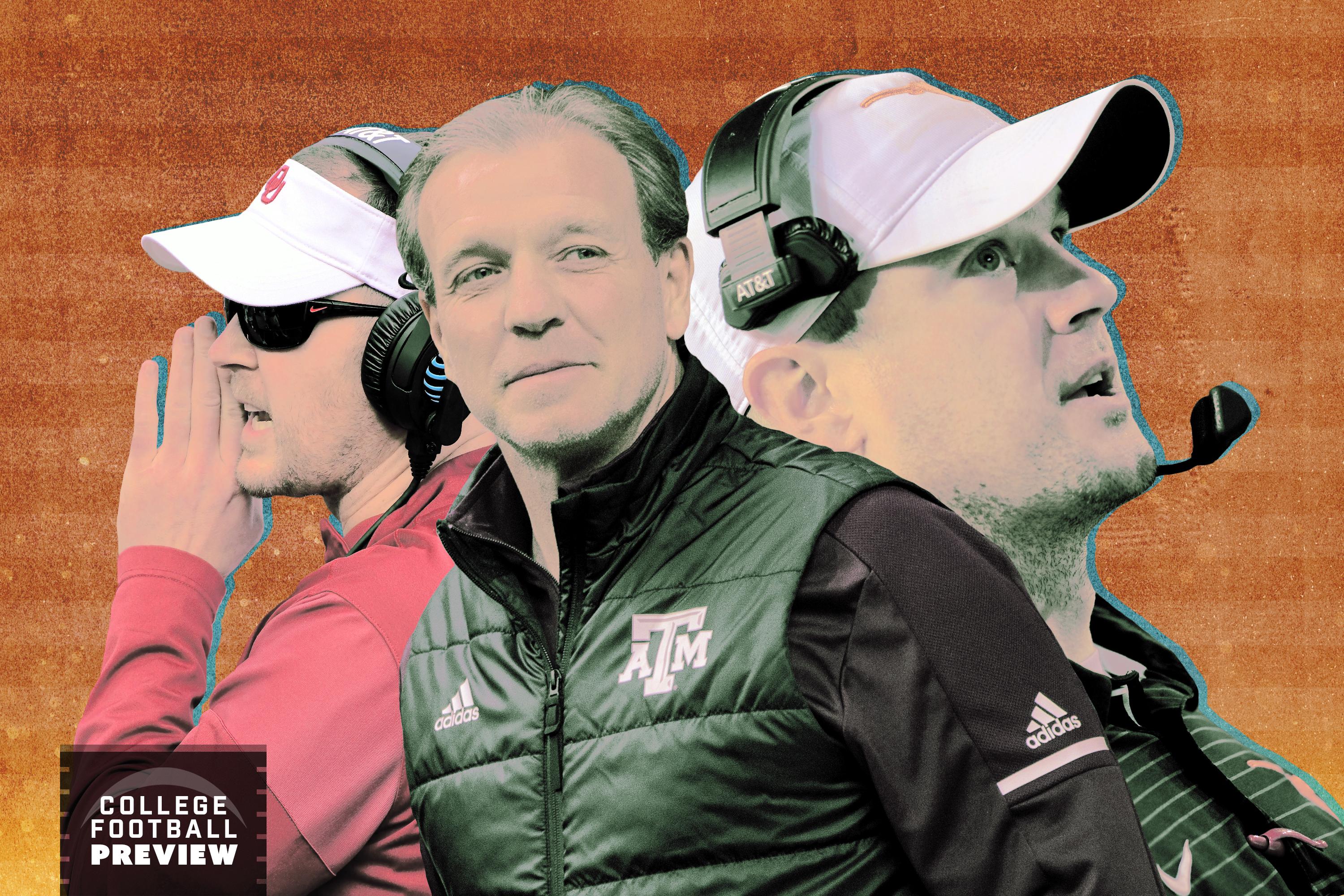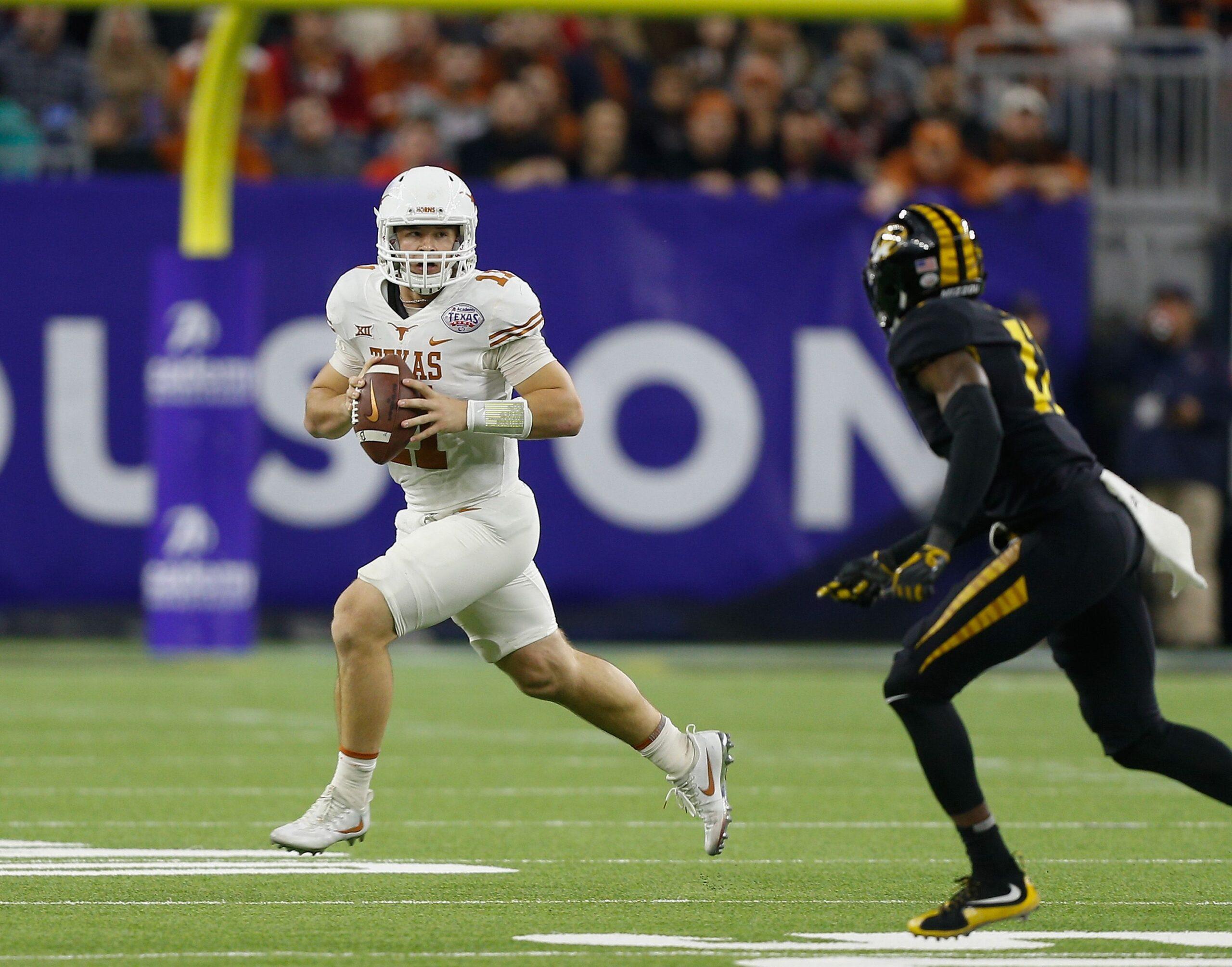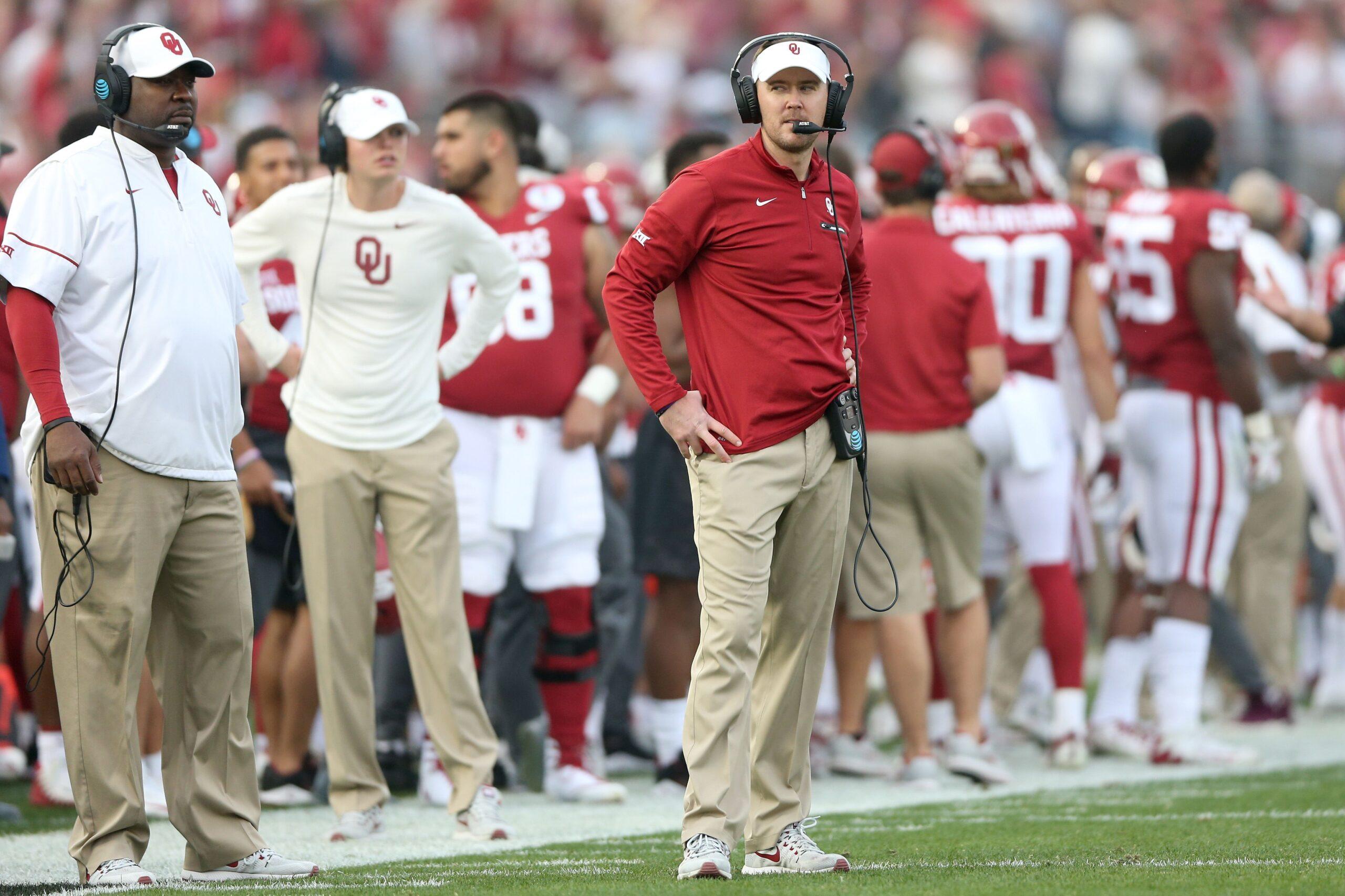The Battle to Be the New King of College Football in Texas
Texas, Texas Au0026amp;M, and Oklahoma all head into the 2018 season with first- or second-year head football coaches. Will Tom Herman, Jimbo Fisher, or Lincoln Riley come to rule a recruiting-rich region?
There’s a college football power vacuum in the state of Texas. The head coaches at Oklahoma, Texas, and Texas A&M—the three schools that have historically dominated recruiting in the region—are all in either their first or second seasons on the job. A&M is no longer in the Big 12 with OU and UT, but the schools still compete for players in one of the most talent-rich areas of the country. Texas hasn’t been this wide open since the 1940s, the last time all three programs hired coaches within a year of one another.
All three are fabulously wealthy and as popular as any NFL team. They rule recruiting within the state, almost regardless of what happens on the field. According to Rivals.com, only once in the past decade has a Big 12 school secured a higher-ranked class than A&M, Texas, or OU (Texas Tech over A&M in 2011). The hierarchy among those three, however, depends almost entirely on the coaching staffs at each program.
It doesn’t matter how good these coaches were early in their careers. History has proved that it’s virtually impossible for all three to succeed simultaneously. A&M’s best seasons in the late 1980s and early ’90s coincided with downturns at Texas and OU, and vice versa. The Aggies haven’t won a conference title since 1998, the same year Mack Brown took over in Austin and a year before Bob Stoops came to Norman. And while A&M no longer has annual matchups with those schools now that it’s in the SEC, it’s still measured against them by fans and recruits in the state of Texas, making the fledgling rivalry between the three newly installed coaches one of the most important in all of college football.
Sooners coach Lincoln Riley got a head start on his new rivals. Stoops stunned the college football world in June 2017 when he retired and elevated his then-33-year-old offensive coordinator to the top job. In doing so, Stoops gifted Riley a readymade juggernaut. Oklahoma entered last season as the two-time defending Big 12 champion with a fifth-year senior QB in Baker Mayfield. Mayfield went on to win the Heisman Trophy and position himself to go no. 1 overall in the NFL draft, and the Sooners went 12-2, won a third straight conference title, and made the College Football Playoff. No one can replace Mayfield, but Oklahoma’s returning offensive firepower (led by running back Rodney Anderson and receiver Marquise Brown) should make the transition easier for Kyler Murray, a two-sport star whom the the Oakland A’s picked no. 9 in this spring’s MLB draft.
Second-year Texas coach Tom Herman has a steeper hill to climb. The Longhorns haven’t had a 10-win season since 2009, when Colt McCoy was throwing passes to Jordan Shipley. Charlie Strong succeeded longtime head coach Brown in 2014, and was fired after posting a 16-21 record over three seasons. Strong used a different starting QB each year that he was in Austin. Not much changed in Year 1 under Herman. Texas went 7-6 last fall while alternating between sophomore Shane Buechele and freshman Sam Ehlinger behind center.
Texas A&M coach Jimbo Fisher, like Herman, is taking over a program seeking a fresh start. A&M made a splash under former coach Kevin Sumlin when it moved to the SEC in 2012, going 10-2 before routing Oklahoma in the Cotton Bowl, but couldn’t sustain that level of success without Heisman winner Johnny Manziel. Fisher, a 52-year-old who won a national title at Florida State, is more proven than Riley or Herman. He left Tallahassee after feuding with administrators over resources, which shouldn’t be an issue in College Station. The Aggies recently spent hundreds of millions of dollars upgrading Kyle Field and gave Fisher the largest coaching contract (10 years, $75 million) in NCAA history.
Riley, Herman, and Fisher all have a chance to own the region for years to come. Coming off his strong debut at Oklahoma, Riley is in the lead. But the balance of power can shift quickly in college football, and the fan bases at the two Texas schools have plenty of reason for optimism.
As a Texas alum, my expectations for this season are unreasonably high. Year 2 is typically when coaches put their fingerprints on a program, and that should be the case with Herman and the offense. The 43-year-old won a national title as Ohio State’s offensive coordinator in 2014, despite having to rely on his third-string QB (Cardale Jones) in the playoff. And Herman registered a 22-4 record in two seasons as the head coach at Houston, with his teams averaging more than 35 points per game in 2015 and 2016.
I’m all in on Ehlinger, who beat out Buechele to be named Texas’s starting quarterback this season. He’s bigger (6-foot-2 and 230 pounds) and more athletic, and his mobility makes him a better fit in Herman’s offense. As a teenage QB in the Big 12, he showed the issues you might expect in 2017: inaccuracy (he completed 57.5 percent of his attempts, compared to 64.3 percent for Buechele) and decision-making (11 touchdowns against seven interceptions). Ehlinger has the higher ceiling and lower floor of the two. He looked like a star in some games, most notably a 40-34 double-overtime victory against Kansas State in which he went 30-of-50 passing for 380 yards with two scores, and he struggled in others, like a 27-23 loss to Texas Tech in which he went 26-of-47 for only 239 yards with two picks.

What impressed me most about Ehlinger was the way he took over some games on the ground. Ehlinger was only average through the air (19-of-39 for 278 yards with a touchdown) in a 29-24 loss to Oklahoma in last year’s Red River Rivalry, but he put his head down, powered through the line, and rushed for a first down basically any time he wanted (22 carries for 106 yards with a score). He’s a battering ram whose skill set is perfect for the sweltering heat of Dallas in early October. Maybe the Sooners just had a terrible defense. Or maybe Ehlinger is the next Tim Tebow.
Ehlinger has an incredible story. He was only 14 when his father collapsed and died while competing in the Escape From Alcatraz Triathlon. With two younger siblings looking up to him, Ehlinger became the man of the house. He carries himself like someone much older than 19, and as an Austin native, seems like the ideal candidate to bring Texas out of the wilderness. Plus, his size and run-first style mean he doesn’t require a great offensive line to thrive, and offensive line has been the team’s Achilles heel. Before Connor Williams went to the Cowboys in the second round of the 2018 draft, the Longhorns hadn’t had an offensive lineman selected since 2008.
Ehlinger gives Texas a chance to escape the QB treadmill it has been on for the last decade. Longhorns fans have recently been burned by five-star QB prospects like Garrett Gilbert, who finished his career at SMU, and four-star recruits like Tyrone Swoopes, who is trying to make the Seahawks roster as a tight end. It’s hard to take home a conference title without a good QB. In fact, the downfall of Sumlin’s tenure at A&M began when three QBs—Kenny Hill (to TCU), Kyle Allen (Houston), and Murray (OU)—transferred out of College Station in the span of one year. Ironically enough, Allen transferred to play for Herman, while Murray is now playing for Riley. There are only a couple degrees of separation between anyone in the state’s relatively insular football culture.
Dealing with that culture will be an adjustment for Fisher. A Nick Saban disciple who spent the majority of his career in the SEC and ACC, Fisher lacks the Texas roots that his peers have. Riley spent eight seasons at Texas Tech learning under Mike Leach, first as a player and later as an assistant. Herman is going into his 21st season coaching in the state in some capacity.
Fisher is known for excelling with an intricate, NFL-style offense as complex as anything run at the next level. This helped him turn three Florida State QBs (Christian Ponder, EJ Manuel, and Jameis Winston) into first-round NFL draft picks. Fisher racked up a 39-3 record between 2012 and 2014, returning the Seminoles to perennial-contender status after six seasons of mediocrity at the end of Bobby Bowden’s tenure. At A&M, he’s hit the ground running when it comes to recruiting. The Aggies have the third-ranked 2019 class in the country, per Rivals.com, behind only Alabama and Georgia. Fisher can offer players something Herman and Riley can’t: the chance for Texas kids to stay close to home while still competing in the SEC, the best conference in the country.
However, for all of Fisher’s success in Tallahassee, Florida State slipped in the ACC over the last three seasons, bottoming out at 5-6 under his shortened reign in 2017. He failed to maintain NFL-caliber production at QB after Winston left in 2015. Fisher was surpassed by Clemson coach Dabo Swinney, who runs a spread offense initially installed by former offensive coordinator Chad Morris. Morris started his career as a Texas high school coach and just took over as the head coach at Arkansas, where he will work in the same division as Fisher.
Fisher may have to adjust his offensive philosophy now that he’s primarily recruiting players from the state of Texas, where high school football is a religion. Many of the spread offensive concepts that now define the sport at every level were created in the Darwinian laboratories of the state’s high school ranks. Almost every QB recruit in Texas has run the spread since middle school. The more traditional offensive schemes that Fisher prefers will be challenging for them to learn. Strong, like Fisher, lacked Texas ties when he came to the area after running a pro-style offense at Louisville. He was forced to change his scheme halfway through his tenure in Austin because his players were so unfamiliar with it.
A&M left the Big 12 in 2012 to get out of the shadow of Texas and OU. However, by moving to the SEC, it may have jumped out of the frying pan and into the fire. The SEC West is the toughest division in college football. Alabama has won five national championships in the past nine years under Saban; LSU and Auburn have also won national titles over the past 15 years. Those schools wage vicious recruiting battles across the Southeast. They wanted A&M to join the SEC to give themselves better opportunities to recruit the state of Texas.
Maintaining recruiting momentum will not be easy for Fisher. He faces a two-pronged fight. He has to keep the other SEC powers out of his state, while also beating back Riley and Herman, who have much easier roads to the playoff in the Big 12.
If there’s a concern for Riley after his sensational debut, it’s on defense. The Sooners collapsed on that side of the ball during a 54-48 double-overtime loss to Georgia in last season’s Rose Bowl. It wasn’t an isolated incident: OU ranked 74th nationally in yards per play allowed in 2017, tied with Texas Tech, a defensive laughingstock beneath head coach Kliff Kingsbury. The Sooners defense has long been a weak link under coordinator Mike Stoops, Bob’s younger brother. However, given how much influence Bob still has in the program, it’s unclear whether Riley has the authority to fire Mike. There are a lot of politics that come with coaching at a school like Oklahoma. Imagine Coach Taylor’s situation on Friday Night Lights, multiplied by a thousand.

To that end, the biggest edge Herman has over Riley may be Longhorns defensive coordinator Todd Orlando, a rising star who was instrumental to Herman’s success at Houston and has quickly adapted to life in the Big 12. The adjustment Orlando made to the conference’s pass-first style was using a dime package with six defensive backs as the team’s base defense. After ranking tied for 35th in yards per play allowed last fall, the Longhorns should be even better in 2018. Texas doesn’t face many offenses with the personnel to exploit it on the ground, especially considering its advantages in speed and athleticism over every conference opponent except the Sooners.
Herman and Riley, like every coach at Texas and OU, will be judged by the game at the State Fair of Texas. It’s always one of the defining matchups in the Big 12, because victories on the field translate to recruiting success off it. Adrian Peterson, who grew up about two hours outside of Dallas, chose OU in 2004 after watching the Sooners beat Texas four straight times.
Everything in college sports starts with recruiting. Even average coaches should be able to attract top-15 national recruiting classes at OU, Texas, and A&M. They all have the talent to be national title contenders. But to whom much is given, much is expected. Someone who can’t win at a high level won’t stick around for long.
The new wave of coaches at these schools will inevitably be compared to one another, and the more success one has, the more likely the other two won’t last. Riley, Herman, and Fisher are living the NCAA version of Alec Baldwin’s monologue from Glengarry Glen Ross: First place is a playoff berth. Second place is a set of steak knives. Third place is you’re fired.

